In cooperation with the representatives of the Slovene police force seconded to the international peacekeeping mission in Kosovo, a new unit of the Kosovo police force (KPS - Kosovo Police Service), a cavalry unit, was founded in Kruševo on 15 March 2006 which had not existed before. It has been put on trial for six months. Twelve police cavalrymen (with six service horses to start with) will be in charge of monitoring mostly the Dragos area in the mountain region of Prizren and the border between Albania and Macedonia where a lot of illegal border crossing, smuggling etc. takes place.
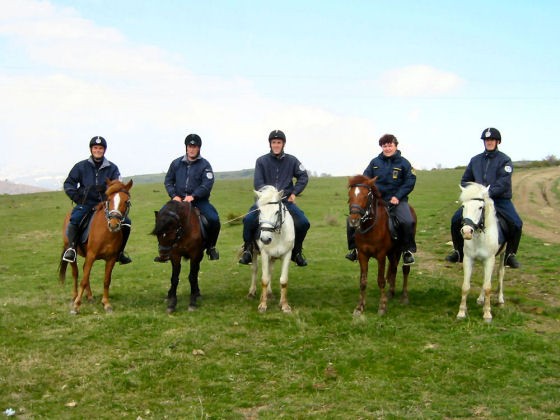 According to Suzana Zevnik, who is otherwise the head of the Service Dogs Training Division on the Police Academy and also currently a member of the Slovene contingent of police officers in the UN mission in Kosovo, the preparations for the founding of the Kosovo cavalry unit lasted some months.
According to Suzana Zevnik, who is otherwise the head of the Service Dogs Training Division on the Police Academy and also currently a member of the Slovene contingent of police officers in the UN mission in Kosovo, the preparations for the founding of the Kosovo cavalry unit lasted some months.
""When I first heard of the idea, I could not imagine how a cavalry could be placed to Kosovo. The whole idea was not in accordance with the Kosovo police plan of work for the year 2006. The police did not have stables, trainers or horses, nor equipment, vehicles or anything else. The project seemed a tough nut to crack but we undertook it anyway. It was hard to imagine how we would be able to buy such horses in the first place as service police horses are supposed to be real "machines", each weighing 500 to 600 kg and can be used for many various tasks. I found it even more difficult to imagine how we would get them to Kosovo, put them in a stable and feed them, not to mention their use or anything else. When the decision came that we would start with work in Kruševo, at first I did not even know where that was. Later I saw that it was situated in the south of the country, in the Prizren region. This part of the territory is like a peninsula indenting between Albania and Macedonia; it is very mountainous and quite remote. There is only about 100 km between Priština and Kruševo, and yet a drive up there takes you four hours in winter."
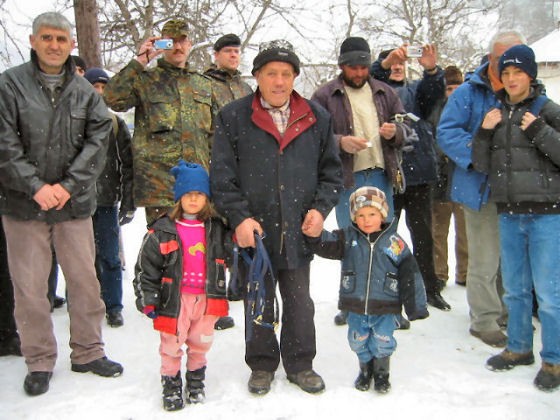 PHOTO 1: People are humble and poor, they live in their isolated world and are somewhat mistrustful. At the beginning they held back, but soon the curiosity took over. A police station is of great importance in a place like Kruševo. The village has only about 400 inhabitants and it is situated in a deep valley by the border with Albania. When we first came to Kruševo a large audience gathered behind the wooden fence which separates the property of the police station from the main village road. They were mostly men; some brought along their grandsons or granddaughters. The youngsters kept fussing around like a swarm of hungry horseflies. They carefully followed my every word, and only when they saw me speaking Serbian to the police officers they loosened up a little. English will not take you far among them...
PHOTO 1: People are humble and poor, they live in their isolated world and are somewhat mistrustful. At the beginning they held back, but soon the curiosity took over. A police station is of great importance in a place like Kruševo. The village has only about 400 inhabitants and it is situated in a deep valley by the border with Albania. When we first came to Kruševo a large audience gathered behind the wooden fence which separates the property of the police station from the main village road. They were mostly men; some brought along their grandsons or granddaughters. The youngsters kept fussing around like a swarm of hungry horseflies. They carefully followed my every word, and only when they saw me speaking Serbian to the police officers they loosened up a little. English will not take you far among them...
Selecting the horses from the locals (bargaining for the price) and a recognition to a policewoman for doing a man's job
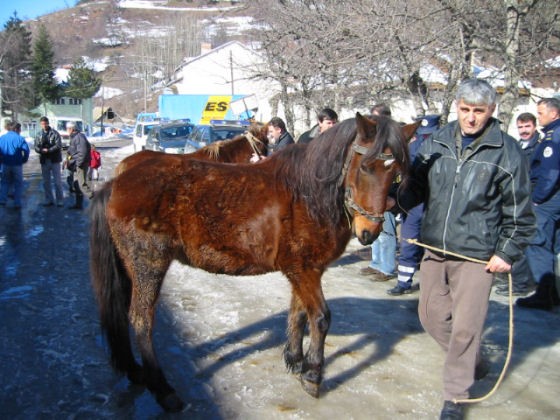 Selecting of horses
Selecting of horses
The selecting of horses was, as Suzana Zevnik puts it, very demanding. The KPS representatives and two peacekeepers had to first negotiate a price with the twenty five locals that came to offer their horses. As the locals wanted to make high profits, they agreed among themselves that a monthly horse hire will amount to 200 Euro. This does not seem very much; however this is a (good) salary of a Kosovo police officer. The KPS representatives offered them 150 Euro, and at the end they finally agreed on 160 Euro which included shoeing.
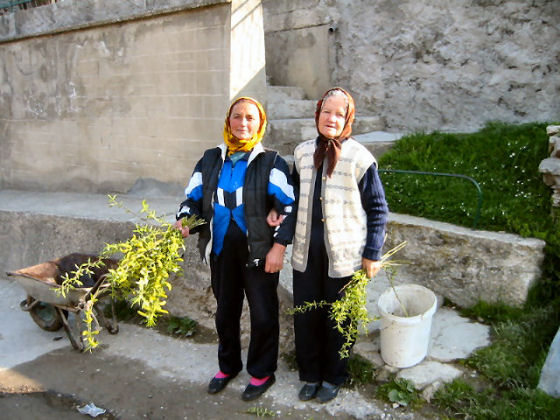
PHOTO 2: The Kruševo villagers are similar to other inhabitants of remote and forgotten places across the world. They kept back at first, though they were curious and always had a broad smile on their face. It was not long when they became inquisitive and talkative, unread and yet full of common sense and humour.
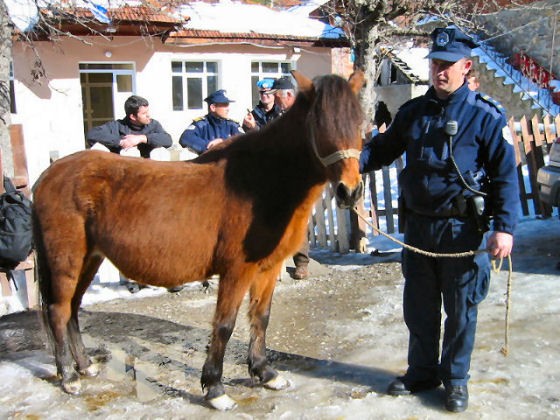 "The locals cashed in their horses very well", writes Zevnik. "The maintenance of a horse in Slovenia is something completely different then in the south of Kosovo. The horse is fed here (in our meaning of the word) three or four months a year which means that they give them a small bundle of hay in some shed that is supposed to be a stable. Horse-keeping practice is indeed something completely different in Kosovo. So these horses are fed only during most severe winter when the snow is almost one metre high and the horses really can not find any food by themselves. Other months the horses are simply let out of their stables, so they can search for their own food in the vicinity. Ponies are incredibly modest animals and will eat anything that is at least a bit edible (dry leaves, roots, young branches, scarce grass and probably other things), yet at the same time they indeed work like horses. They are used as packhorses and the mare is in addition to that expected to have foals ..."
"The locals cashed in their horses very well", writes Zevnik. "The maintenance of a horse in Slovenia is something completely different then in the south of Kosovo. The horse is fed here (in our meaning of the word) three or four months a year which means that they give them a small bundle of hay in some shed that is supposed to be a stable. Horse-keeping practice is indeed something completely different in Kosovo. So these horses are fed only during most severe winter when the snow is almost one metre high and the horses really can not find any food by themselves. Other months the horses are simply let out of their stables, so they can search for their own food in the vicinity. Ponies are incredibly modest animals and will eat anything that is at least a bit edible (dry leaves, roots, young branches, scarce grass and probably other things), yet at the same time they indeed work like horses. They are used as packhorses and the mare is in addition to that expected to have foals ..."
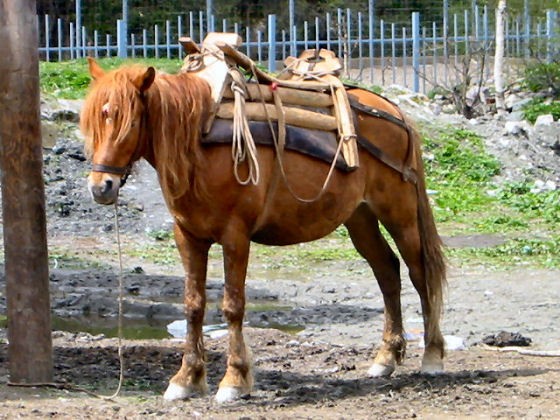 PHOTO 3: The ponies in Kosovo are heavily loaded and they have to carry different loads for many hours every day (wood, fodder, objects for sale, water, field products and similar). Sometimes you could only see a stack of hay moving along the street. You could not even see the horse - except his hooves - under that entire load.
PHOTO 3: The ponies in Kosovo are heavily loaded and they have to carry different loads for many hours every day (wood, fodder, objects for sale, water, field products and similar). Sometimes you could only see a stack of hay moving along the street. You could not even see the horse - except his hooves - under that entire load.
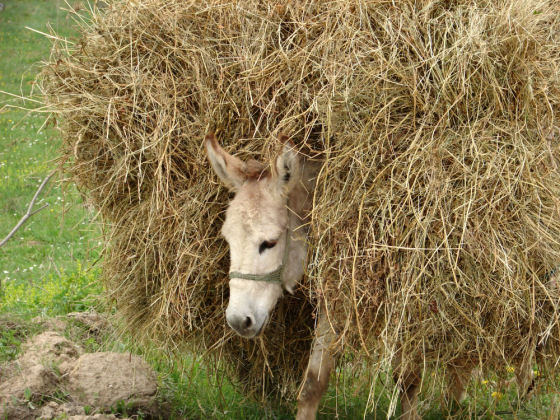 Photo: Robi RIBIČ
Photo: Robi RIBIČ
Suzana Zevnik continues to tell the story of how villagers commented on her every word and move as she was selecting the horses for KPS among the offered number of horses in Kruševo. "Gradually they started accepting my decisions approvingly and even generously forgave me that I am a woman, because I was "international" and partly also because I come from Slovenia. They would never let their women pick out horses because that is simply not becoming - that is a man's job and women have little say in it. One of the villagers approached me at the end and said with an expression of utter amazement, how such a "difficult and important" task was entrusted to a woman: "You really know your job!" She said that those horse bidders who were at the same time police officers in KPS and wanted to work in the cavalry unit had some advantage in the selection procedure. The idea really was not bad as it meant that they will work with their own horses and therefore take better care of them. On the other side it also considerably improved the financial situation of those families whose members were in the KPS.
Complications with the transportation of equipment - race with time
"And then the time race began. Our commander-in-chief wanted that the opening to happen a month and a half after the decision to establish a cavalry unit has been made. But naturally it did not go that fast. We need it to affirm contracts of horse hire, select the equipment and affirm contracts for that as well, and then transport the entire equipment here. You can not even imagine how complicated that can be!" is how Suzana Zevnik describes the constant complications.
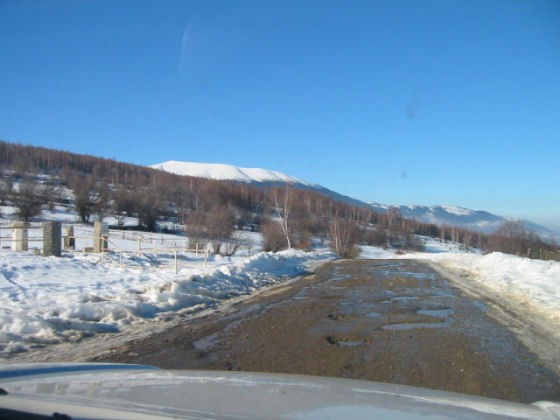 PHOTO 4: The road was narrow, full of potholes and snow, therefore we adjusted the speed. Even just the sitting in the passenger's seat with the constant speeding, braking, hopping and swerving made you so tired we were completely "exhausted" upon arrival. This picture was taken upon our first arrival. There was nothing else to do but place snow chains on in the middle of our journey... It did not matter that we did it in the middle of the road.
PHOTO 4: The road was narrow, full of potholes and snow, therefore we adjusted the speed. Even just the sitting in the passenger's seat with the constant speeding, braking, hopping and swerving made you so tired we were completely "exhausted" upon arrival. This picture was taken upon our first arrival. There was nothing else to do but place snow chains on in the middle of our journey... It did not matter that we did it in the middle of the road.
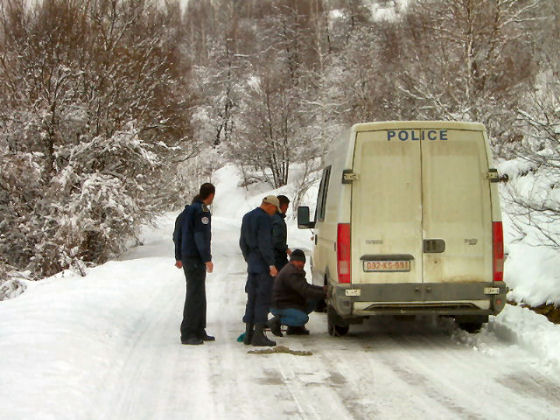
"As there are no special air cargo flights to Prishtina, the cargo had to be sent together with passenger luggage and that was not that easy. The volume of cargo is limited and if the maximum is achieved, things stay on the ground. That is why the entire freight remained on the ground the first day whereas the next day one of the eight packages remained. When finally all eight packages arrived we did not have all the documents, so another day went by. When we finally got all the documentation and the packages, it started snowing - 20 cm on the first day, 25 cm on the second, and time passed..."
Instructions for police officers of the new cavalry unit
When the entire equipment finally arrived to Kruševo they started putting it together. This is how Suzana Zevnik recalls the event: "It seemed that the locals saw some parts of the equipment for the first time. It is true that they live and work with horses every day, however, the equipment that they use is completely different. The horses wear hoods made of a combination of leather and chains, they do not use bridles. They use "samar" for carrying the load which is a packsaddle made of wood and a thin lining of horsehair and fabric. It does not look the least bit like an English saddle. If someone ever rides a horse, then he uses the samar or sits on a bare horseback. They are not really accustomed to riding as sport or as a mean of transport. Thus we had to start from the beginning, i.e. how to construct a saddle, what are parts of the saddle, how they are called and what they are for, how we attach a saddle on a horseback, etc. Then we presented some basic facts about the stable and riding bridle - how it is constructed and how it is used. Naturally, we also explained what a bridle is, what it is for, how it is put into the horse's mouth..."
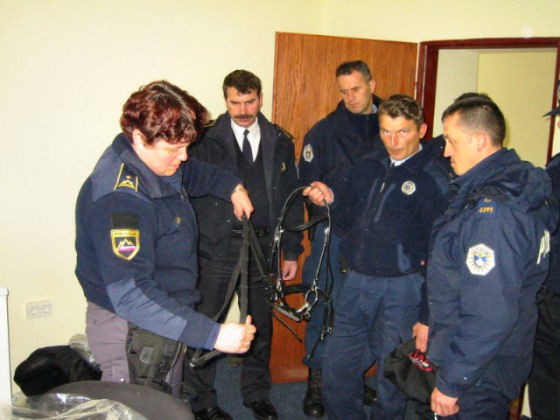 PHOTO 5: Instructions for the eager Kosovo police officers: "Now, let's repeat that again!" and "How is this thing called again?" or "Where does this strap go?" "It is a great feeling to spread the knowledge onto people that really want it and listen to your every word with interest and attention."
PHOTO 5: Instructions for the eager Kosovo police officers: "Now, let's repeat that again!" and "How is this thing called again?" or "Where does this strap go?" "It is a great feeling to spread the knowledge onto people that really want it and listen to your every word with interest and attention."
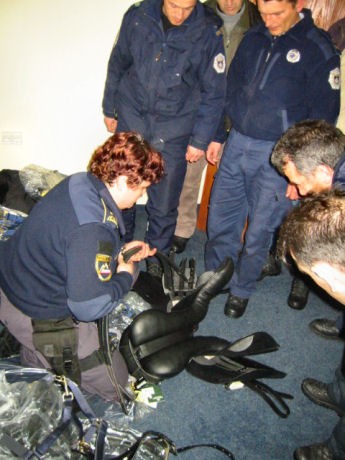
Opening
Finally, the "D-Day", i.e. the opening, came. Everyone of note gathered at the opening as this was a big deal for the small village with "forgotten" inhabitants. The first cavalry unit was founded in their village and the people took great pride in it.
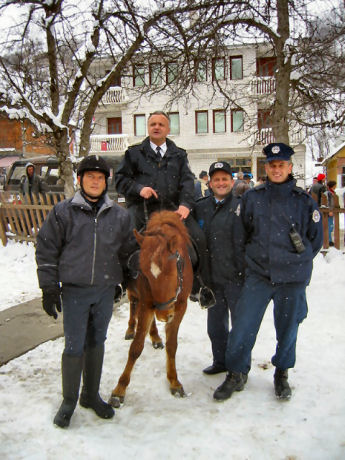
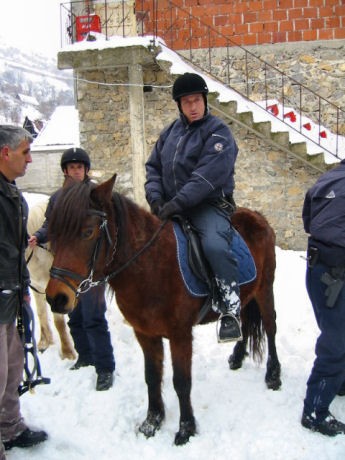
PHOTO 6: The opening - everyone wanted to take a picture: "This is history in the making, is it not?" On the left side there is a police officer on a horse who later on took up work in the cavalry unit. He was incredibly serious the whole time; this was a very important occasion for him...
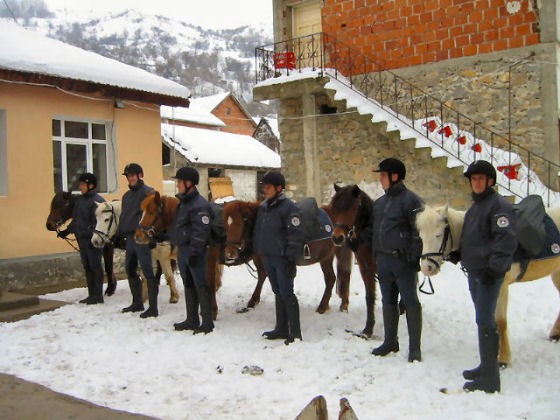
PHOTO 7: These are all KPS police officers who were active members of the cavalry unit after the founding.
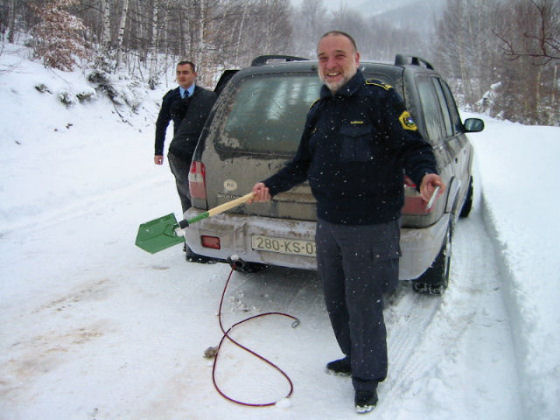 PHOTO 8: Sadly, not everyone was able to make it to the opening. On the photo is Janez Mužič, also a representative of the Slovene police force, who got stuck in the snow with three other passengers some five kilometres outside Kruševo.
PHOTO 8: Sadly, not everyone was able to make it to the opening. On the photo is Janez Mužič, also a representative of the Slovene police force, who got stuck in the snow with three other passengers some five kilometres outside Kruševo.
Some more interesting details ...
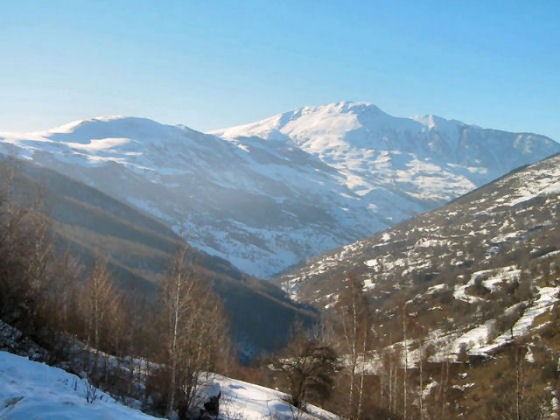
PHOTO 9: The landscape is very beautiful - when we first arrived it was covered in snow and the near mountain tops were gleaming in the sun. That day for the first time I saw the mountains which are in the neighbouring Albania. They would make excellent ski centres if only the conditions were more favourable. The landscape is covered in snow for about six to seven months a year when the mountains are barely passable, except for the beaten tracks known only to local inhabitants and smugglers.
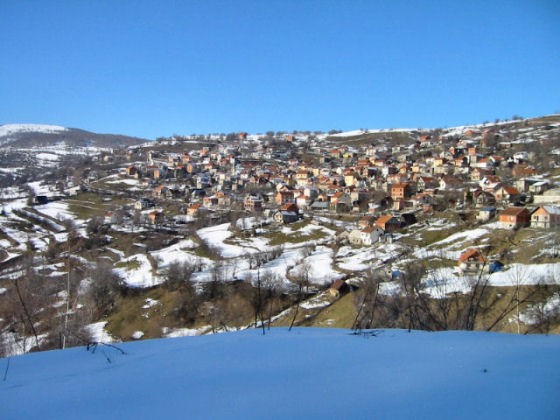
PHOTO 10: The living conditions in these areas are incredibly poor. Scarcely scattered little villages are mostly inhabited by farmers. These places are very remote and not abreast with the times and agricultural activities are the only source of survival in this area. People are engaged in stockbreeding and producing of fodder for the animals, there is hardly any real farming. Some villagers are engaged also in beekeeping, otherwise the self-supply prevails - there are usually some hens picking around the house and in a small uneven stable a few sheep and goats, a cow or a horse are considered as a substantial fortune. The houses are small and badly kept, looking more like a flock of chickens on the steep hill above the village road. Muddy village roads lead to them and everything is covered in mud and water. There is no trace of a sewage system.
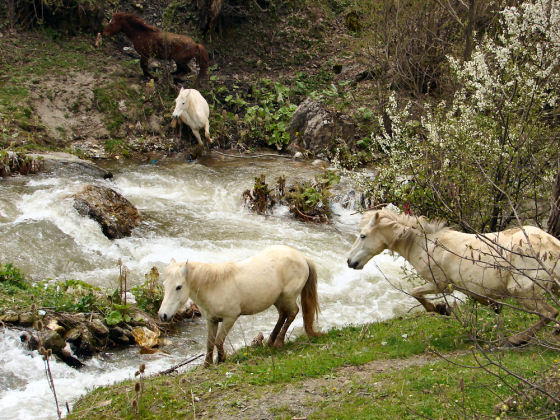 Photo: Robi RIBIČ
Photo: Robi RIBIČ
PHOTO 11: The inhabitants are Goranci who speak Macedonian, comprehend Serbian and some Albanian very well. In the time of the Miloševič regime they did not experience the war, as they were never hostile towards the Serbs, on the other hand they were so remote, small and "insignificant" that the main events did not occur around them. Goranci are the inhabitants of these hilly areas which are slowly moving into the lowland and the cities and they are also masters in the preparation of food.
More photos:
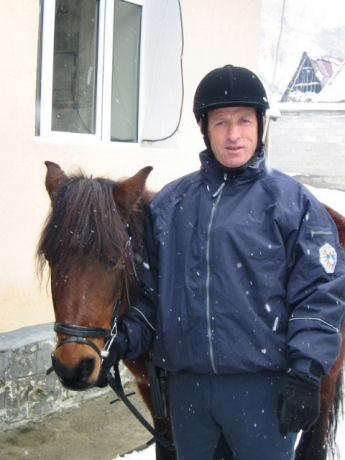
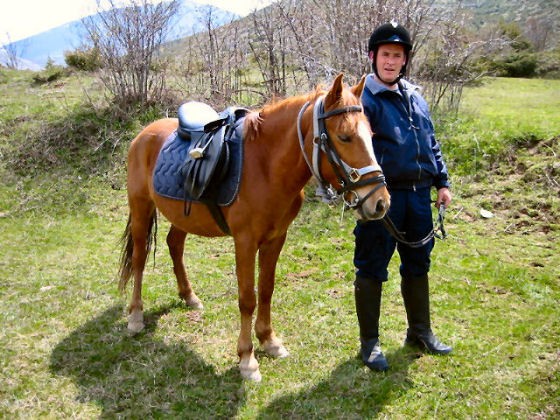
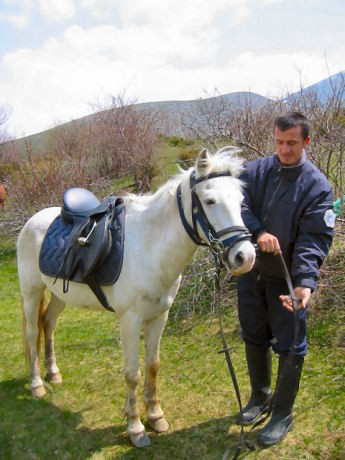
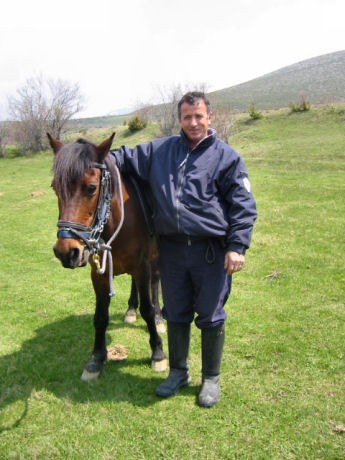
all photographs and accompanying text: Suzana Zevnik

